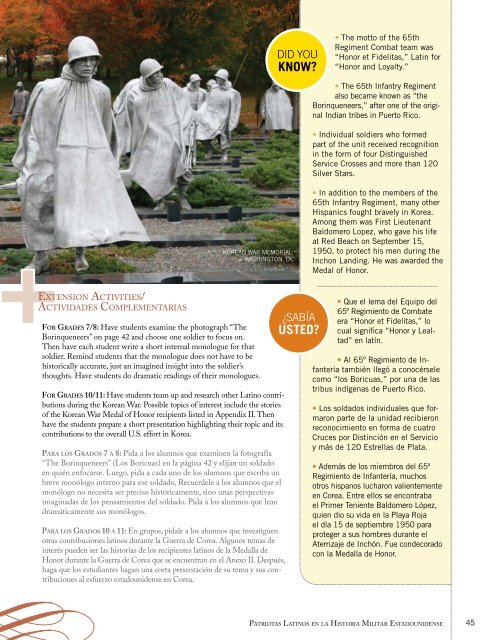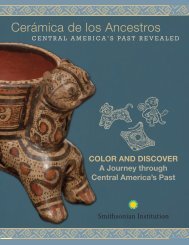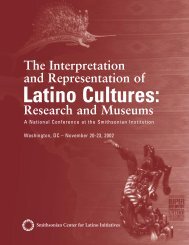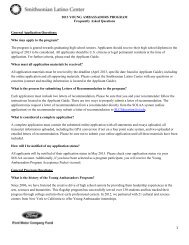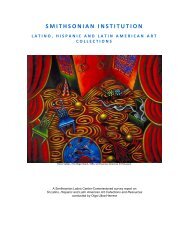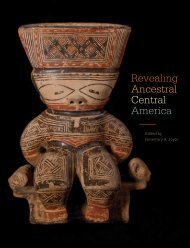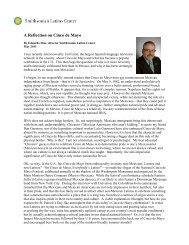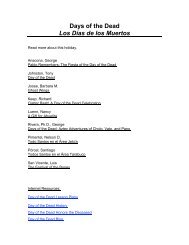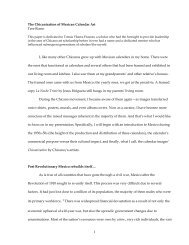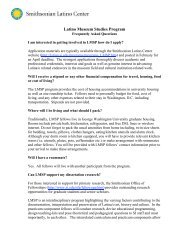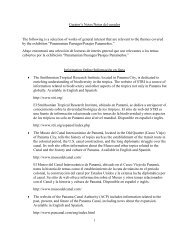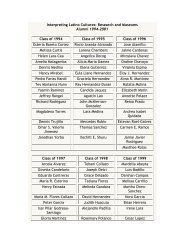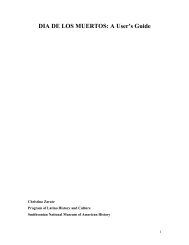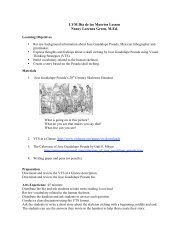(1861–1865) la Guerra Civil - Smithsonian Latino Center ...
(1861–1865) la Guerra Civil - Smithsonian Latino Center ...
(1861–1865) la Guerra Civil - Smithsonian Latino Center ...
You also want an ePaper? Increase the reach of your titles
YUMPU automatically turns print PDFs into web optimized ePapers that Google loves.
Did you<br />
know?<br />
• The motto of the 65th<br />
Regiment Combat team was<br />
“Honor et Fidelitas,” Latin for<br />
“Honor and Loyalty.”<br />
• The 65th Infantry Regiment<br />
also became known as “the<br />
Borinqueneers,” after one of the original<br />
Indian tribes in Puerto Rico.<br />
• Individual soldiers who formed<br />
part of the unit received recognition<br />
in the form of four Distinguished<br />
Service Crosses and more than 120<br />
Silver Stars.<br />
Korean War Memorial,<br />
Washington, DC<br />
• In addition to the members of the<br />
65th Infantry Regiment, many other<br />
Hispanics fought bravely in Korea.<br />
Among them was First Lieutenant<br />
Baldomero Lopez, who gave his life<br />
at Red Beach on September 15,<br />
1950, to protect his men during the<br />
Inchon Landing. He was awarded the<br />
Medal of Honor.<br />
Have students examine the photograph “The<br />
Borinqueneers” on page 42 and choose one soldier to focus on.<br />
Then have each student write a short internal monologue for that<br />
soldier. Remind students that the monologue does not have to be<br />
historically accurate, just an imagined insight into the soldier’s<br />
thoughts. Have students do dramatic readings of their monologues.<br />
Have students team up and research other <strong>Latino</strong> contributions<br />
during the Korean War. Possible topics of interest include the stories<br />
of the Korean War Medal of Honor recipients listed in Appendix II. Then<br />
have the students prepare a short presentation highlighting their topic and its<br />
contributions to the overall U.S. effort in Korea.<br />
Pida a los alumnos que examinen <strong>la</strong> fotografía<br />
“The Borinqueneers” (Los Boricuas) en <strong>la</strong> página 42 y elijan un soldado<br />
en quién enfocarse. Luego, pida a cada uno de los alumnos que escriba un<br />
breve monólogo interno para ese soldado. Recuerdele a los alumnos que el<br />
monólogo no necesita ser preciso históricamente, sino unas perspectivas<br />
imaginadas de los pensamientos del soldado. Pida a los alumnos que lean<br />
dramáticamente sus monólogos.<br />
En grupos, pidale a los alumnos que investiguen<br />
otras contribuciones <strong>la</strong>tinos durante <strong>la</strong> <strong>Guerra</strong> de Corea. Algunos temas de<br />
interés pueden ser <strong>la</strong>s historias de los recipientes <strong>la</strong>tinos de <strong>la</strong> Medal<strong>la</strong> de<br />
Honor durante <strong>la</strong> <strong>Guerra</strong> de Corea que se encuentran en el Anexo II. Después,<br />
haga que los estudiantes hagan una corta presentación de su tema y sus contribuciones<br />
al esfuerzo estadounidense en Corea.<br />
¿Sabía<br />
usted?<br />
• Que el lema del Equipo del<br />
65º Regimiento de Combate<br />
era “Honor et Fidelitas,” lo<br />
cual significa “Honor y Lealtad”<br />
en <strong>la</strong>tín.<br />
• Al 65º Regimiento de Infantería<br />
también llegó a conocérsele<br />
como “los Boricuas,” por una de <strong>la</strong>s<br />
tribus indígenas de Puerto Rico.<br />
• Los soldados individuales que formaron<br />
parte de <strong>la</strong> unidad recibieron<br />
reconocimiento en forma de cuatro<br />
Cruces por Distinción en el Servicio<br />
y más de 120 Estrel<strong>la</strong>s de P<strong>la</strong>ta.<br />
• Además de los miembros del 65º<br />
Regimiento de Infantería, muchos<br />
otros hispanos lucharon valientemente<br />
en Corea. Entre ellos se encontraba<br />
el Primer Teniente Baldomero López,<br />
quien dio su vida en <strong>la</strong> P<strong>la</strong>ya Roja<br />
el día 15 de septiembre 1950 para<br />
proteger a sus hombres durante el<br />
Aterrizaje de Inchón. Fue condecorado<br />
con <strong>la</strong> Medal<strong>la</strong> de Honor.<br />
45


